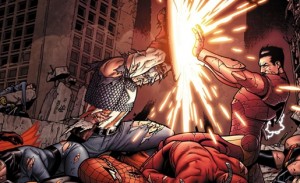 2016 was supposed to be the year of videogame adaptations. Finally, after years and years and years of failures dating all the way back to 1993 with the release of the utterly atrocious “Super Mario Bros.” movie, directors, producers and studios have attempted to bring beloved videogame properties to life on the big screen, with no luck. Even the best videogame movies, such as “Mortal Kombat”, are still only considered good by videogame movie standards and fail when measured up to literally anything else. This year, things were meant to change, damn it! We were going to have “Warcraft”, “Ratchet & Clank”, “Assassin’s Creed”, “Angry Birds”, and they were all going to be good! Well, okay, maybe not that last one, but things were looking up! As it turns out, no, they’re not – “Ratchet & Clank” was critically panned, proving once and for all that a fun game does not necessarily make a good movie, and according to early reviews “Warcraft” might be even worse. It really says something when friggin’ “Angry Birds” is currently the highest rated videogame movie of all time, doesn’t it? I still have hope for “Assassin’s Creed”, which is due to release in December, but considering the fact that A) most of it is set in modern times as opposed to a historical setting like in the games, B) it comes out mere days after “Star Wars”, and C) that horrible Kanye West song somehow made it into the trailer makes me think that the people behind it have no idea what they’re doing.
2016 was supposed to be the year of videogame adaptations. Finally, after years and years and years of failures dating all the way back to 1993 with the release of the utterly atrocious “Super Mario Bros.” movie, directors, producers and studios have attempted to bring beloved videogame properties to life on the big screen, with no luck. Even the best videogame movies, such as “Mortal Kombat”, are still only considered good by videogame movie standards and fail when measured up to literally anything else. This year, things were meant to change, damn it! We were going to have “Warcraft”, “Ratchet & Clank”, “Assassin’s Creed”, “Angry Birds”, and they were all going to be good! Well, okay, maybe not that last one, but things were looking up! As it turns out, no, they’re not – “Ratchet & Clank” was critically panned, proving once and for all that a fun game does not necessarily make a good movie, and according to early reviews “Warcraft” might be even worse. It really says something when friggin’ “Angry Birds” is currently the highest rated videogame movie of all time, doesn’t it? I still have hope for “Assassin’s Creed”, which is due to release in December, but considering the fact that A) most of it is set in modern times as opposed to a historical setting like in the games, B) it comes out mere days after “Star Wars”, and C) that horrible Kanye West song somehow made it into the trailer makes me think that the people behind it have no idea what they’re doing.
But why are things turning out like this? Why do people seem unable to make good videogame movies? Some people say that videogames are simply unfilmable – they’re a different medium entirely, and once you remove the interactive element you lose most of the immersion. No offense, but these people are idiots. First of all, books and comics are also a different medium, but they’ve given us some damn fine movies over the years. Second of all, if games are only ever entertaining if they’re being played, then why is the Let’s Play culture thriving so much? Millions of people are flocking towards famous YouTubers in order to watch them play videogames. If the interactive element was truly so important for immersion, then surely the Let’s Play culture would’ve made no sense?
If you ask me, the big problem stems from the fact that filmmakers simply don’t understand their source material properly. They don’t understand the significance of what they’re filming, and how to properly narrate it to their audience. For example, the way you build suspense in a game is a lot different from the way you do it in a movie, which is why a lot of horror game adaptations (such as “Silent Hill” or “Resident Evil”) just don’t work. The goal of the filmmaker is to narrate the same experience to his or her audience that the player would get from playing the game. Instead, what directors are trying to do is take elements from the game and just shove them in the movie for no reason other than to say “Hey, remember THAT from the game? It’s here too!”, but without understand just WHY they’re there. The “Silent Hill” movie I mentioned is like a goldmine for this kind of thing, as I could literally spend an entire article writing about it, but let’s just limit it to two examples, shall we? “Silent Hill” is an adaptation of the first “Silent Hill” game – remember that, that is important. In “Silent Hill 3”, after the main character Heather loses her father, she goes on a car ride to the town of Silent Hill and has a discussion about the fact that her life as she knew it is basically over. All the while, the song “Letter From The Lost Days” plays in the background, which, as you can hear, is rather relevant to the conversation. In the “Silent Hill” movie, the main character takes her daughter to Silent Hill with her car, and the same song plays, but since the context is so different the choice of music doesn’t really make sense. Similarly, one of the most famous characters from the series is the eponymous Pyramid Head, who first appeared in “Silent Hill 2” as a manifestation of main character James’ guilt over having committed a murder, with a design inspired by a painting of an executioner. In the movie, Pyramid Head is simply a demon who shows up for a little bit and chases the protagonist around for absolutely no reason other than for the director to wink to the fans and say “See, this is just like the games!” As you may have noticed, both of those examples include trying to shove things into an adaptation of the first “Silent Hill” game which weren’t even part of it in the first place.
Will we ever see a good videogame movie? Hopefully! The adaptation of the game “The Last of Us”, which is generally regarded as one of the best games of all time, was written by the same person who wrote and directed the game, so when, or rather if that ever gets off the ground we might be looking at the world’s first great videogame movie. Fingers crossed!


 There’s no denying the fact that eBooks have become immensely popular over the last few years, and while they’re nowhere near close enough to matching dead tree books in terms of popularity (and probably never will be), their market share is growing each year thanks to the push by various companies with interest in the area, most specifically Amazon. Nowadays even the most basic phones and tablets you can buy can read ePubs and Mobis with the right software installed on them, which has led to more people than ever before giving electronic books a try. But what’s the best way to read them? Hell, is there even such a thing as a best way to do that?
There’s no denying the fact that eBooks have become immensely popular over the last few years, and while they’re nowhere near close enough to matching dead tree books in terms of popularity (and probably never will be), their market share is growing each year thanks to the push by various companies with interest in the area, most specifically Amazon. Nowadays even the most basic phones and tablets you can buy can read ePubs and Mobis with the right software installed on them, which has led to more people than ever before giving electronic books a try. But what’s the best way to read them? Hell, is there even such a thing as a best way to do that?  Marvel’s 2006 event comic event “Civil War” was one of the company’s biggest ones, scoping across the entire Marvel universe. Pretty much every single Marvel hero who was alive and on Earth at the time was involved in one way or another, whether in the main books or in their own spinoff series. At the time, “Civil War” received universal critical acclaim for completely shattering and reshaping the Marvel universe and presenting a fresh new perspective on the hero vs hero conflict (remember – up until that point, the classic formula of hero vs hero fights involved only fighting for a bit before teaming up against a bad guy, and there was no bad guy in sight during “Civil War”). While fan opinion on the story is more mixed these days (and with good reason – some of the content within is pretty questionable), the fact that its 2016 movie adaptation
Marvel’s 2006 event comic event “Civil War” was one of the company’s biggest ones, scoping across the entire Marvel universe. Pretty much every single Marvel hero who was alive and on Earth at the time was involved in one way or another, whether in the main books or in their own spinoff series. At the time, “Civil War” received universal critical acclaim for completely shattering and reshaping the Marvel universe and presenting a fresh new perspective on the hero vs hero conflict (remember – up until that point, the classic formula of hero vs hero fights involved only fighting for a bit before teaming up against a bad guy, and there was no bad guy in sight during “Civil War”). While fan opinion on the story is more mixed these days (and with good reason – some of the content within is pretty questionable), the fact that its 2016 movie adaptation  Today, gaming technology is at its peak. Games like “The Last of Us” bring us Hollywood-worthy story and performances, technologies like the Oculus Rift and the HTC Vive bridge the gap between the virtual world and our own and mobile platforms allow us to bring our games with us literally wherever we go without needing to worry about taking anything other than the essential items we carry every day. With the gaming industry being by far the most successful financially, overshadowing the movie and music industries, it’s pretty clear that we’re living in a golden age of gaming no matter how you look at it. Games have never been more immersive, more groundbreaking, more… Well, good. Or have they?
Today, gaming technology is at its peak. Games like “The Last of Us” bring us Hollywood-worthy story and performances, technologies like the Oculus Rift and the HTC Vive bridge the gap between the virtual world and our own and mobile platforms allow us to bring our games with us literally wherever we go without needing to worry about taking anything other than the essential items we carry every day. With the gaming industry being by far the most successful financially, overshadowing the movie and music industries, it’s pretty clear that we’re living in a golden age of gaming no matter how you look at it. Games have never been more immersive, more groundbreaking, more… Well, good. Or have they?  It’s no secret that I read a lot. Like, a TON. I don’t always read a lot, true, but my average is 3-4 books a week. That’s about a book every 2 days, which is a lot more than most people read. I’ve received two questions regarding that fact – one of them is how I’m able to read so much, and the other is where I find all those hundreds of books to read. Well, the answer to the first question is obvious – I just pick up a book and I read it, simple as that. I don’t bother with any speed reading techniques or anything of this sort. Naturally, I read between 400 and 500 words per minute, depending on the text, which is a speed that I’m very comfortable with. At that speed, it takes me roughly 6 hours to read a 400-page novel, but again – if the text flows well and the words are relatively simple it can go faster. My “trick”, if you can even call it that, is that I dedicate roughly 2-3 hours per day to reading.
It’s no secret that I read a lot. Like, a TON. I don’t always read a lot, true, but my average is 3-4 books a week. That’s about a book every 2 days, which is a lot more than most people read. I’ve received two questions regarding that fact – one of them is how I’m able to read so much, and the other is where I find all those hundreds of books to read. Well, the answer to the first question is obvious – I just pick up a book and I read it, simple as that. I don’t bother with any speed reading techniques or anything of this sort. Naturally, I read between 400 and 500 words per minute, depending on the text, which is a speed that I’m very comfortable with. At that speed, it takes me roughly 6 hours to read a 400-page novel, but again – if the text flows well and the words are relatively simple it can go faster. My “trick”, if you can even call it that, is that I dedicate roughly 2-3 hours per day to reading.